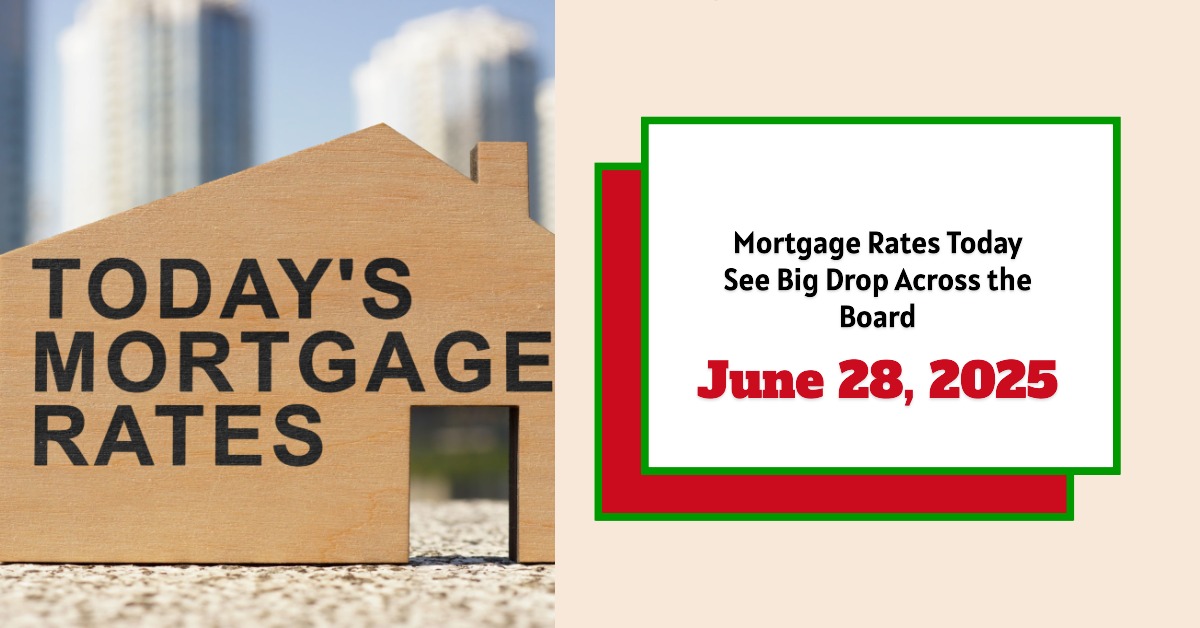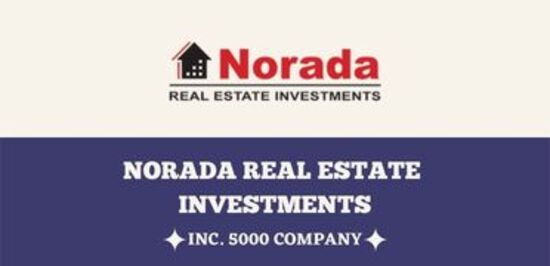As of June 28, 2025, the average 30-year fixed mortgage rate has decreased to 6.74%, down from 6.75% in the previous week. This decline represents a drop of 17 basis points from last week’s average of 6.91%. If you're considering taking out a mortgage or refinancing your current home loan, knowing these updated rates will help you make informed financial decisions.
Mortgage Rates Today June 28, 2025: Rates See Big Drop Across the Board
Key Takeaways
- The 30-year fixed mortgage rate is now at 6.74%.
- The 15-year fixed mortgage rate has fallen to 5.74%.
- Refinancing rates have seen some changes, with the 30-year fixed refinance rate rising to 7.12%.
- Understanding what influences these rates can help you when entering the market.
Current Mortgage Rates
Today's mortgage rates show a dynamic landscape of options for prospective homebuyers and current homeowners looking to refinance. Below is a summary of the current rates as reported by Zillow:
| Mortgage Type | Current Rate | 1-Week Change | APR | 1-Week APR Change |
|---|---|---|---|---|
| 30-Year Fixed Rate | 6.74% | Down 0.17% | 7.19% | Down 0.18% |
| 20-Year Fixed Rate | 6.37% | Down 0.21% | 6.81% | Down 0.14% |
| 15-Year Fixed Rate | 5.74% | Down 0.22% | 6.03% | Down 0.23% |
| 10-Year Fixed Rate | 5.78% | Down 0.15% | 6.04% | Down 0.03% |
| 7-Year ARM | 7.29% | Down 0.15% | 7.80% | Down 0.01% |
| 5-Year ARM | 7.50% | Up 0.30% | 7.93% | Up 0.14% |
Additionally, if you are interested in government-backed loans, consider the following rates:
| Government Loan Type | Current Rate | 1-Week Change | APR | 1-Week APR Change |
|---|---|---|---|---|
| 30-Year Fixed Rate FHA | 7.50% | Up 0.18% | 8.55% | Up 0.19% |
| 30-Year Fixed Rate VA | 6.25% | Down 0.15% | 6.46% | Down 0.15% |
| 15-Year Fixed Rate FHA | 5.84% | Up 0.25% | 6.81% | Up 0.24% |
| 15-Year Fixed Rate VA | 5.76% | Down 0.16% | 6.10% | Down 0.15% |
Refinance Rates
Current refinance rates are also pivotal for homeowners looking to lower their payments or change their loan terms. Here’s how today’s refinance rates break down:
| Refinance Loan Type | Current Rate | 1-Week Change | APR | 1-Week APR Change |
|---|---|---|---|---|
| 30-Year Fixed Refinance | 7.12% | Up 0.12% | 7.19% | Down 0.18% |
| 20-Year Fixed Refinance | 6.37% | Down 0.21% | 6.81% | Down 0.14% |
| 15-Year Fixed Refinance | 5.84% | No Change | 6.03% | Down 0.23% |
| 10-Year Fixed Refinance | 5.78% | Down 0.15% | 6.04% | Down 0.03% |
| 5-Year ARM Refinance | 7.47% | Down 0.29% | 7.93% | Up 0.14% |
Note that the 30-year fixed refinance rate has increased slightly; this indicates it’s a vital time to evaluate your refinancing options.
Mortgage Payments Under Current Rates
If you're curious about what your mortgage payments will look like under the current rates, here’s a breakdown of monthly payments for different loan amounts using the 30-year fixed rate of 6.74%.
Monthly Payment on a $300,000 Mortgage For a $300,000 mortgage, your monthly payment will be approximately $1,948. This amount includes principal, interest, property tax, and homeowners insurance, typical of fixed monthly payments.
Monthly Payment on a $400,000 Mortgage If you're looking at a $400,000 mortgage, the monthly payment comes to about $2,597. It's essential to factor in that for larger loan amounts, many lenders may require a larger down payment or stricter qualification criteria.
Monthly Payment on a $500,000 Mortgage Finally, for those with a $500,000 mortgage, expect to pay around $3,247 per month. As your mortgage increases, the financial responsibility escalates, making it crucial to evaluate your overall financial health and budget before committing.
These figures help give a clear view of what to expect based on current rates, and they can significantly aid in budgeting for a home purchase or refinancing strategy.
Factors Influencing Mortgage Rates
Understanding the mortgage rate's fluctuations requires a grasp of the crucial influences behind them. Three main factors that significantly impact mortgage rates include:
- The Federal Reserve: The Fed plays a pivotal role in influencing mortgage rates through its monetary policy. When the Fed sets lower interest rates to stimulate the economy, lenders often follow suit by lowering mortgage rates, making borrowing cheaper for homebuyers. Conversely, if the Fed raises rates to combat inflation, mortgage rates typically rise as well.
- Inflation: Inflation erodes the purchasing power of money which can directly impact mortgage rates. When inflation is on the rise, lenders adjust mortgage rates upwards to maintain their margins and to compensate for the decreased value of money over time. Keeping inflation in check is critical for stabilizing mortgage rates.
- 10-Year Treasury Yield: This yield is often seen as a benchmark for long-term mortgage rates. When investors expect strong economic growth, they tend to sell Treasury bonds, which drives the yield higher. A rising yield usually leads to higher mortgage rates, as lenders demand more return on their loans.
Additionally, broader economic conditions and the demand for home loans significantly play a role. For example, if consumer confidence is strong and more people are likely to apply for loans, lenders might increase rates to balance demand, thereby controlling the risk of lending.
Related Topics:
Mortgage Rates Trends as of June 27, 2025
Mortgage Rate Predictions for the Next 3 Years: 2026, 2027, 2028
Expert Rate Predictions for 2025
Economic forecasts for mortgage rates are varied. For instance, housing economists and organizations like the Mortgage Bankers Association (MBA) and Fannie Mae have provided insight into future trends:
- Fannie Mae predicts that mortgage rates may hover around 6.5% by the end of 2025. They expect that if inflation is under control, there’s potential for rates to lower, influenced by periodic adjustments from the Fed.
- The MBA also suggests that rates might stabilize slightly lower than current levels by the end of the year. Key factors in these predictions include the overall health of the housing market and the economic recovery journey.
- Some experts foresee a gradual decrease in rates based on signs of easing inflation and more favorable economic conditions, which typically lead to lower interest demands from banks.
- Conversely, predictions are often clouded with uncertainty due to global events, inflation pressures, and changes in government policy. It’s prudent for potential buyers and refinancing homeowners to stay updated as predictions can change based on the latest economic indicators.
Overall, monitoring these forecasts provides essential context for potential homebuyers and those looking to refinance.
Buying and Refinancing Considerations
With fluctuations in mortgage rates, it’s crucial for homebuyers and those considering refinancing to keep informed about the best practices for navigating this environment. Key strategies include:
- Getting Pre-Approved: This will provide you with an idea of what you can afford and can set you up for a smoother closing process. Pre-approval helps in identifying appropriate price ranges and strengthens your negotiating position with sellers.
- Shopping Around for Lenders: Different lenders may offer various rates and terms. It is wise to compare multiple lenders to find the best deal available for your specific circumstances. Interest rates can vary significantly depending on the lender's pricing structure and risk assessment.
- Considering Temporary Rate Buydowns: Some buyers are looking into temporary buydown options to lower their mortgage rates for the initial years of their loans. A buydown is where the seller pays for the interest rate to be temporarily reduced, allowing buyers to enjoy lower payments initially.
- Understanding the “Lock-in” Effect: Many homeowners are reluctant to sell due to enjoying low rates on their existing mortgages. This creates a limited inventory in the housing market, driving competition and raising prices for new buyers.
Invest Smarter in a High-Rate Environment
With mortgage rates remaining elevated this year, it's more important than ever to focus on cash-flowing investment properties in strong rental markets.
Norada helps investors like you identify turnkey real estate deals that deliver predictable returns—even when borrowing costs are high.
HOT NEW LISTINGS JUST ADDED!
Connect with a Norada investment counselor today (No Obligation):
(800) 611-3060
Also Read:
- Will Mortgage Rates Go Down in 2025: Morgan Stanley's Forecast
- Expect High Mortgage Rates Until 2026: Fannie Mae's 2-Year Forecast
- Mortgage Rate Predictions 2025 from 4 Leading Housing Experts
- Mortgage Rates Forecast for the Next 3 Years: 2025 to 2027
- 30-Year Mortgage Rate Forecast for the Next 5 Years
- 15-Year Mortgage Rate Forecast for the Next 5 Years
- Why Are Mortgage Rates Going Up in 2025: Will Rates Drop?
- Why Are Mortgage Rates So High and Predictions for 2025
- Will Mortgage Rates Ever Be 3% Again in the Future?
- Mortgage Rates Predictions for Next 2 Years
- Mortgage Rate Predictions for Next 5 Years
- Mortgage Rate Predictions: Why 2% and 3% Rates are Out of Reach
- How Lower Mortgage Rates Can Save You Thousands?
- How to Get a Low Mortgage Interest Rate?
- Will Mortgage Rates Ever Be 4% Again?



